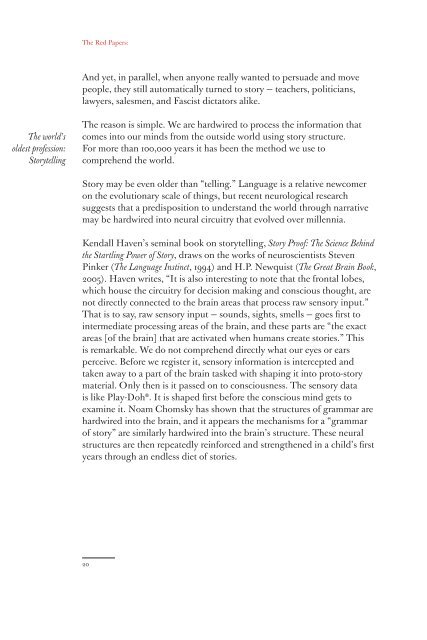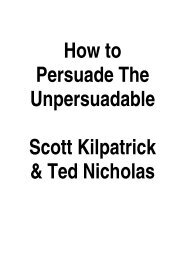1rZwMNa
1rZwMNa
1rZwMNa
You also want an ePaper? Increase the reach of your titles
YUMPU automatically turns print PDFs into web optimized ePapers that Google loves.
The Red Papers:<br />
And yet, in parallel, when anyone really wanted to persuade and move<br />
people, they still automatically turned to story — teachers, politicians,<br />
lawyers, salesmen, and Fascist dictators alike.<br />
The world’s<br />
oldest profession:<br />
Storytelling<br />
The reason is simple. We are hardwired to process the information that<br />
comes into our minds from the outside world using story structure.<br />
For more than , years it has been the method we use to<br />
comprehend the world.<br />
Story may be even older than “telling.” Language is a relative newcomer<br />
on the evolutionary scale of things, but recent neurological research<br />
suggests that a predisposition to understand the world through narrative<br />
may be hardwired into neural circuitry that evolved over millennia.<br />
Kendall Haven’s seminal book on storytelling, Story Proof: The Science Behind<br />
the Startling Power of Story, draws on the works of neuroscientists Steven<br />
Pinker (The Language Instinct, ) and H.P. Newquist (The Great Brain Book,<br />
). Haven writes, “It is also interesting to note that the frontal lobes,<br />
which house the circuitry for decision making and conscious thought, are<br />
not directly connected to the brain areas that process raw sensory input.”<br />
That is to say, raw sensory input — sounds, sights, smells — goes first to<br />
intermediate processing areas of the brain, and these parts are “the exact<br />
areas [of the brain] that are activated when humans create stories.” This<br />
is remarkable. We do not comprehend directly what our eyes or ears<br />
perceive. Before we register it, sensory information is intercepted and<br />
taken away to a part of the brain tasked with shaping it into proto-story<br />
material. Only then is it passed on to consciousness. The sensory data<br />
is like Play-Doh®. It is shaped first before the conscious mind gets to<br />
examine it. Noam Chomsky has shown that the structures of grammar are<br />
hardwired into the brain, and it appears the mechanisms for a “grammar<br />
of story” are similarly hardwired into the brain’s structure. These neural<br />
structures are then repeatedly reinforced and strengthened in a child’s first<br />
years through an endless diet of stories.






